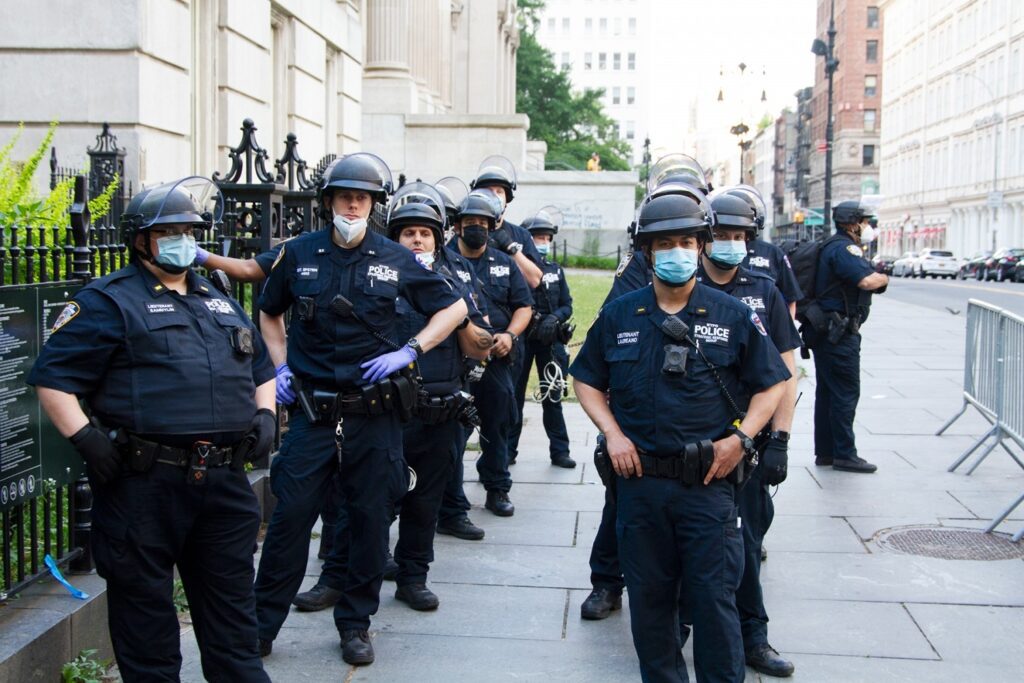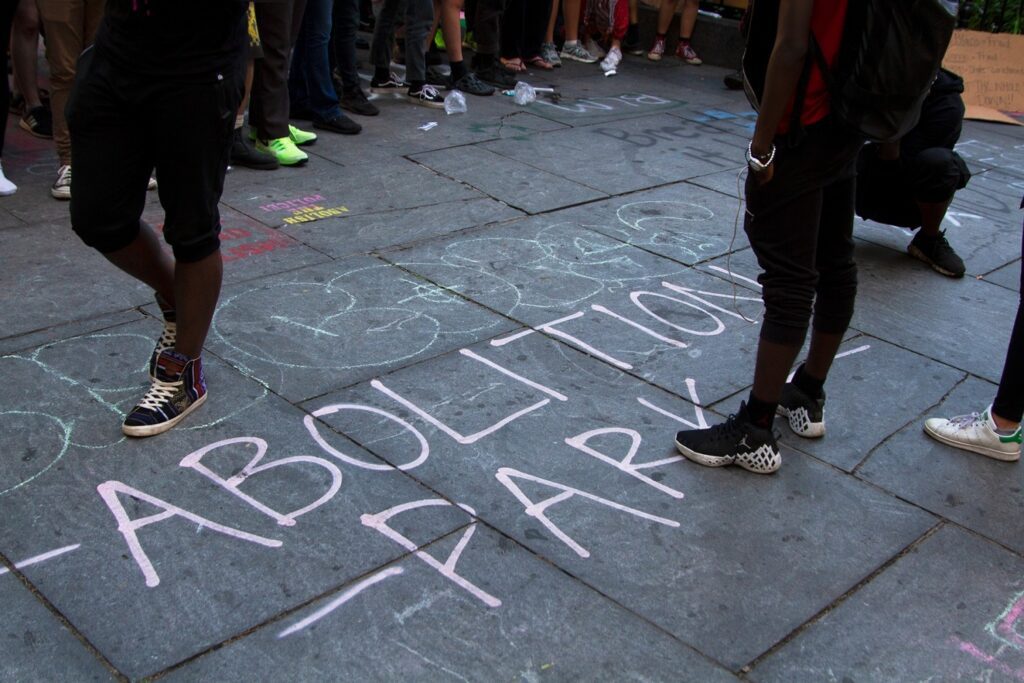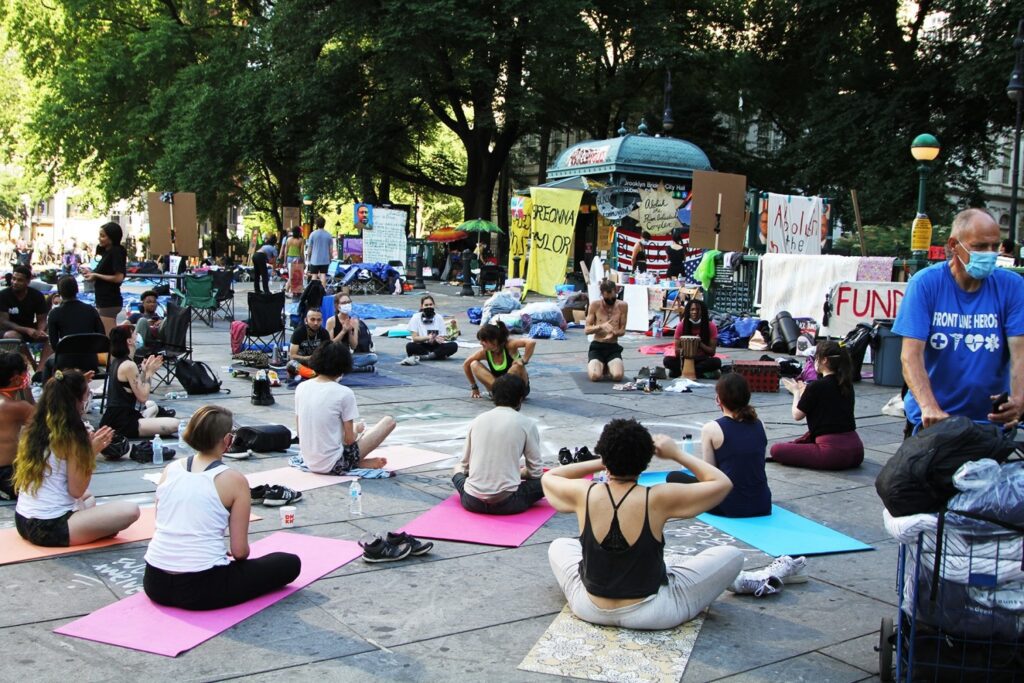At 6:30 a.m. on Sunday morning, an hour after sunrise, about 100 protesters and two dozen police faced off on the edge of City Hall Park in New York City.
“I don’t see no riot here! Why are you in riot gear?” chanted the crowd, locked arm-in-arm three rows deep and spanning the northern perimeter of the park.
The officers were from the NYPD Strategic Response Group, a unit charged with handling “citywide mobilizations, civil disorders, and major events.” They donned batons, twist-tie handcuffs, and helmets; their presence has become a familiar sight at the Black Lives Matter protests that have rocked the city, and nation, since the police killing of George Floyd in Minneapolis in late May.
The spark for the early morning confrontation? A pop-up canopy, akin to what one might see at a youth soccer game or family picnic, that had been protecting tables of books from heavy rain the previous afternoon. The collection, which included Martin Luther King Jr.’s autobiography and By the Light of My Father’s Smile by Alice Walker, made up the “people’s library,” one of many resource stations set up at Occupy City Hall. Also referred to as the City Hall Autonomous Zone, or Abolition Park — depending on who you ask — the around-the-clock protest began the previous Tuesday in an open plaza adjacent to the limestone-pillared building where the city’s laws are passed and spending is decided.
The overnight protesters had grown from 27 the first night to around 200, with daytime and evening supporters swelling into the thousands, according to organizers. Most wore face masks, but social distancing in the crowded space was difficult. The occupation is in response to the closed-door negotiation of New York City’s budget and the organizers’ demands to defund at least $1 billion from the NYPD’s almost $6 billion annual budget and reinvest that money into community services. On Monday morning, Mayor Bill de Blasio said that his office had reached a deal with the City Council to cut $1 billion from the NYPD’s operating budget for fiscal year 2021, largely by shifting school policing to the Board of Education’s budget and blocking the hire of some new officers. Tuesday at 11:59 p.m. is the deadline for Mayor de Blasio and the City Council to agree on their budget negotiations for fiscal year 2021, and the morning of the deadline began with a clash between protesters and police.
Leaders of the occupation tell Rolling Stone they reject this plan for the budget. But that Sunday morning, they were just focused on maintaining their autonomous community in the park. “They turned us up too early in the goddamn morning!” yelled Jonathan Lykes, 30, through a megaphone to the still-linked human barrier. After the sleeping and lounging protesters jumped to attention when police entered the usually police-free park, Lykes and other organizers with Occupy City Hall then successfully negotiated the riot cops’ dispersal; the protesters had agreed to leave any tarps, tents or canopies down when it wasn’t raining. NYC Parks Penal Law forbids pitching a tent in city parks. Shelters were also a point of contention at the 2011 Occupy Wall Street protest in Zuccotti Park, a 10-minute walk farther downtown.

Riot police during the Sunday-morning standoff
Reed Dunlea for Rolling Stone
“Everyone take a deep breath in. Do you feel free?” asked Lykes. “If people can take another nap, please do. We have a long day.”
Some protesters returned to their makeshift sleeping spaces. Others began chatting and milling about. Having just woken up to the commotion, I walked to the designated bathrooms that had been provided by an art space 10 blocks north. “Bathroom Guards,” holding signs in the air, led delegations of relief a few times an hour to whatever nearby business was currently offering up its toilets. A “coffee table jazz” Youtube playlist trickled through a Bose bluetooth speaker at the cold brew station as another day of struggle had begun.
Occupy City Hall is organized by an ad hoc coalition loosely called the Black Collective, made up of nonprofit, political, and individual organizers.
Tatiana Hill, 32, is part of that collective, and is an organizer with VOCAL-NY, a statewide grassroots organization working with low-income members affected by HIV/AIDS, drugs, incarceration, and homelessness. “They have a $6 billion budget for police officers, when we know that communities are suffering. Our communities need this funding, not police officers. Police officers are literally creating harm in our communities rather than healing them,” she said.
In the past month, the mayor imposed the city that never sleep’s first curfew since 1943, insisted that his constituents not believe their own eyes when witnessing NYPD vehicles ramming into crowds, and oversaw the kettling and beating of protesters across New York. And after running on a police-reform platform but taking literally five years to fire Eric Garner’s killer, the six-foot-five Boston native and 2020 presidential dropout dragged his feet on endorsing a billion-dollar slash from the NYPD’s budget for its 36,000 uniformed officers, by far the largest police department in the United States.
City Council Leader Cory Johnson, who initially pushed the number of $1 billion, backed up the protesters. “I share [Occupy City Hall’s] concerns,” he said in an email to Rolling Stone. “And along with my colleagues in the Council have publicly committed to fighting for over a billion in cuts to NYPD spending in next year’s budget, as well as reimagining policing and reinvesting in communities and social services.” (The NYPD declined to comment for this story, and the Police Benevolent Association of the City of New York and the Sergeants Benevolent Association did not respond to multiple requests for comment.)
Organizers of Occupy City Hall were not impressed with de Blasio’s announcement on Monday. “It’s trickery. It’s pretending to answer our demands. It sounds like they’re defunding the NYPD but they’re literally just moving things around,” said Hill, who pointed to moving the NYPD’s School Safety Agents, uniformed officers in schools who do not carry guns, to the Board of Education’s budget. A full NYPD hiring freeze or layoffs also do not appear to be on the table, but the New York Times reports that over 1,000 new hires won’t happen.
New York City Public Advocate Jumaane Williams issued a press release Monday morning stating he would refuse to sign a tax authorization required by the City Charter to implement the final budget if that budget did not move away from school policing or implement a full NYPD hiring freeze.
Because the budget process is so opaque, the public will likely not have a chance to comb through these items until the budget is agreed upon and announced. The number of $1 billion might be reached, but specifics may not be available.
Over the weekend at Occupy City Hall, though, the protest felt much larger than a municipal budget. It was hard to miss the massive display of illuminated radical slogans whenever night fell. An artist who goes by the 83rd, 36, who reclaimed his name from the NYPD’s 83rd Precinct in Brooklyn, was working with a collective called the Illuminator to project a list of policing demands on a building across the street from the park. He recounted an interaction with police in Penn Station when he was young. “The cop said, ‘Stop right there or I’ll put two in your back,’” he said. “I felt dehumanized when the whole thing was over.”

Chalk and spray paint covers the sidewalks inside Occupy City Hall
Reed Dunlea for Rolling Stone
The 83rd is now projecting his five-point message to end qualified immunity, pass a Civilian Defense Act, divest the police, invest in black communities, and end petty-crime arrests on the front of the David N. Dinkins Manhattan Municipal Building, a 40-story building looming over the park whose architecture can only be described as Roman imperial.
Experiencing that violence, and proposing community-based solutions, is why Hill said it was important for Occupy City Hall to be completely and unequivocally black-led. “We need black voices in the forefront. Because privilege exists even in these spaces that are supposed to be for us,” she said.
The space they’ve created on the concrete and sparse grass next to City Hall is an ever-changing protest, collaboration center, soapbox, performance space, and party. Spray paint and chalk slogans fill the sidewalks, and hand-painted signs decorate the surrounding fences and barricades. When I first showed up on Saturday evening, the smell of sage was thick in the air. Carlos Rosario, 32, was fanning a bundle of it with goose feathers that he found next to the Hudson River. “We come here today to raise vibration, and give love and peace to the people,” he said, while soaking protesters who came by in its smoke.
At any given time over the course of the night I spent there, there were speeches, people singing, DJs spinning (tracks from Da Baby, Pop Smoke, Soulja Boy), and marches from different boroughs coming and going. There was a celebratory but serious vibe, and at many times arguments broke out among participants from seemingly endless walks of life.
Besides feuding over whether or not people could stay dry, the cops were mostly scattered among the trees lining City Hall, separated from the protesters. But on Sunday morning, a pair of NYPD officers entered the north side of the park, seemingly confused about what was going on there and looking to walk through. They were swiftly met with a chorus of boos, “get out of here,” and a protester blowing a very loud whistle. The officers quickly turned back and walked around the other side of the metal police barriers instead. Occupy City Hall had become a space most everyone (who did not like police) was welcome.
“Groups are just showing up and taking space. We’re trying to not tell people what to do and just let them do their own thing. Which can also be tricky,” said Brandon West, 35, who is with Occupy City Hall and also running for City Council in Brooklyn. “There’s no program. We’re trying to not overdo it on that front. It’s decentralized.”
West gives me a tour of the stations that have organically popped up in the space: the people’s bodega with miscellaneous supplies, a medic station (donned by a red-duct-tape cross), a press table, water stations, multiple PPE stations, an art area full of paint brushes and stencils, a small but adorable garden zone, a voter-registration booth, a prisoner letter-writing station, a clothing donation area that always seemed well-stocked with socks, laundry land, and its own WiFi network.
Laundry land does daily en masse drop-offs and pickups of bedding and clothes, with no ticket system for identifying whose clothes are whose. Mackenzie Jamieson, 23, who had moved from volunteering as a medic to laundry land, says that despite what sometimes looks like chaos, everything just works. “Any person working any of these stations just figures it out. A lot of it’s luck and a lot of it’s trust,” she says.
There are also about 10 food preparation and distribution tables, ranging from snacks to hot meals to coffee.
“It’s incredible to see how the food gets here, and also how people who don’t know each other are creating a system for feeding everyone,” says Charles Khan, 31, with Occupy City Hall and the Strong Economy for All Coalition (a coalition of labor unions and community organizations), who says they’re relying on donations for food. He said it started with snacks and water, “but now it’s like a mall food court.” He listed rotisserie chicken, vegan Chinese food, and a taco truck as some of the highlights before he had to leave our conversation to help with a nearby medical emergency (which were happening frequently, as many homeless New Yorkers were participating in the space, utilizing the free-of-charge services provided, and receiving swift attention from medics when necessary).
Despite the freewheeling activities, conversations, and services, on Saturday evening at 8:30, the Black Collective took center stage, calling a people’s assembly to reorient the growing crowd to the demands of Occupy City Hall. Organizers read a joint statement, community agreement, and a community vow. “We are extremely proud to watch this movement grow,” the statement read, before laying out how the space has evolved. A people’s mic began, with the crowd repeating each line spoken over the sound system: “Respect black leadership/This is a black-led direct action/No Karens.” The assembly ended after an hour.

An 8 a.m. yoga session on Sunday morning
Reed Dunlea for Rolling Stone
After a month of marches and protests, this type of semipermanent space is important to the participants.
“They’ve been marching for a while. And there’s something we can focus on, which is to have a just budget,” Public Advocate Williams, who stopped by Occupy City Hall, told Rolling Stone. “Let’s focus right at where decisions are being made on a regular basis. Let’s hold court right at City Hall. Let’s get it done. Let’s make sure they hear us.”
Williams pointed to the obvious comparison, in name and location, to Occupy Wall Street. “It was great to see that energy. I saw things immediately that must have been corrections of some of the things in Zuccotti Park. It was instantly just organized a lot better,” said Williams, pointing to the prolific services being organized, lists of nearby bathrooms available, and information tables.
A glaring difference between Occupy Wall Street and Occupy City Hall is the specificity of the demands. Occupy Wall Street called for a redistribution of wealth in America, and made a wide-ranging list of demands to achieve that, including a guaranteed living wage, free college, and open borders. It also gave the country an easily-understood lexicon of the 99 percent vs. the 1 percent in the fight for who holds economic power and the power derived from it.
“A lot of the times people reflect back on Occupy Wall Street and they treat it as a failure,” says Frances Fox Piven, professor at City University of New York’s Graduate Center. “I think that’s a mistake. Occupy had a tremendous impact on the way that we think about politics in the United States. It was Occupy that raised the issue of extreme inequality to the very top of the political agenda.”
But Occupy City Hall’s central demand is much more immediate, with a number and an end date.
For some activists, the call to defund the NYPD by nearly one-fifth of its budget was just not enough. Radical collective Decolonize This Place, known for its massive annual Anti-Columbus Day tours and a string of FTP (“Fuck The Police”) actions, tweeted that Occupy City Hall has been co-opted by politics rather than pushing for more radical movement goals: Reforming the system of policing is not enough; abolishing the police should be the stated goal.
Two cardboard signs hanging on the fence of City Hall Park on Sunday morning read “It was $5 billion when BDB [Bill de Blasio] started” and “$1 billion is not enough.”
“Clearly the space has become a lot bigger than just the budget. There are folks here fighting for abolition who want to fight in perpetuity,” says West.
Indeed, there are still vast and varying protests against racist policing taking place across New York City. Fifteen thousand people showed up two weeks ago in Brooklyn to rally for black trans lives, and Sunday saw big Queer Liberation and Reclaim Pride protests, complete with NYPD crackdowns. The course of events for the Black Lives Matter movement in New York, and nationally, will likely remain as fluid, overwhelming, and diverse as a string of @JusticeForGeorgeFloydNYC Instagram stories.
At around 7 a.m. on Sunday morning, Jonathan Lykes and I sat down on a bench in Occupy City Hall and discussed the police standoff that had just gone down regarding tents in the park.
“Within two and a half minutes, all of our people were awake, and 150 people were up and chanting and pushing the police out of the park,” said Lykes. He pointed to the community-building and collaboration that Occupy City Hall has been doing in order to make that kind of radical, immediate, coordinated action possible.
The night before, Lykes had led black occupiers in a call-and-repeat song: “I love being black/I love the color of my skin/Cause it’s the skin that I’m in/I love the texture of my hair/And I rock it everywhere.”
The crowd yelled the words back at him, over and over.
“We believe in holistic energy. This is a process of shifting our energies to come into a space intentionally,” says Lykes. “If we don’t get what we want, we will turn up and escalate tactics until we get our demands heard. We will be intentional and strategic.”
